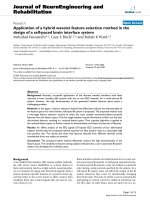THE MAKING OF a POSTMODERN CELEBUTANTE HOW PARIS HILTON’S PUBLIC PERSONA IS CONSTRUCTED = SỰ tạo THÀNH NGƯỜI NỔI TIẾNG hậu HIỆN đại HÌNH ẢNH PARIS HILTON TRƯỚC CÔNG CHÚNG
Bạn đang xem bản rút gọn của tài liệu. Xem và tải ngay bản đầy đủ của tài liệu tại đây (825.53 KB, 76 trang )
VIETNAM NATIONAL UNIVERSITY, HANOI
UNIVERSITY OF LANGUAGES AND INTERNATIONAL STUDIES
FACULTY OF LINGUISTICS & CULTURES OF ENGLISH-SPEAKING COUNTRIES
***
GRADUATION PAPER
THE MAKING OF A POSTMODERN
CELEBUTANTE: HOW PARIS HILTON’S PUBLIC
PERSONA IS CONSTRUCTED
Supervisor: Nguyễn Thanh Hà, Ph.D.
Student: Lưu Lan Phương
Course: QH2017.E1.SPCLC
HÀ NỘI – 2021
ĐẠI HỌC QUỐC GIA HÀ NỘI
TRƯỜNG ĐẠI HỌC NGOẠI NGỮ
KHOA NGƠN NGỮ & VĂN HĨA CÁC NƯỚC NĨI TIẾNG ANH
KHĨA LUẬN TỐT NGHIỆP
SỰ TẠO THÀNH NGƯỜI NỔI TIẾNG HẬU HIỆN
ĐẠI: HÌNH ẢNH PARIS HILTON TRƯỚC CÔNG
CHÚNG
Giáo viên hướng dẫn: TS. Nguyễn Thanh Hà
Sinh viên: Lưu Lan Phương
Khóa: QH2017.E1.SPCLC
HÀ NỘI – 2021
ACCEPTANCE PAGE
I hereby state that I: Lưu Lan Phương, QH2017.E1, being a candidate for the degree
of Bachelor of Arts, accept the requirements of the College relating to the retention
and use of Bachelor’s Graduation Paper deposited in the library.
In terms of these conditions, I agree that the origin of my paper deposited in the
library should be accessible for the purposes of study and research, in accordance
with the normal conditions established by the librarian for the care, loan or
reproduction of the paper.
Signature
Date
ACKNOWLEDGEMENTS
I would like to express my deepest gratitude to my supervisor, Dr. Nguyễn
Thanh Hà. The completion of my paper would not have been possible without her
unwavering guidance, invaluable insight, constructive criticism and unparalleled
dedication. Despite my severe lack of experience and knowledge about the field of
qualitative research, she has always shown me unfailing patience, encouragement
and kindness that have become one of my biggest motivations to overcome such a
challenging experience. Thank you for believing in me even when I could not do
the same to myself.
I would also like to extend my appreciation to my friends: Trang, Hà Anh
and Hà Linh for their emotional support, tremendous assistance and positive
affirmations. Without their nurturing and sympathetic companionship, I would not
have the mental strength to carry on with this research.
Last but not least, I am deeply indebted to my parents as they have fostered
my resilience and determination ever since I was a child. Despite our distance and
generational differences, they have continuously provided me with the highest level
of compassion, faith and encouragement throughout this process.
i
ABSTRACT
Paris Hilton, one of the most controversial figures in the American show
business since the early 2000s, is commonly regarded as a “celebutante” – someone
who possesses both fame and fortune with the absence of talents or achievements to
justify her status. Despite the skepticism and criticism, Hilton’s lasting appeal
continues to exceed expectations and has recently brought about a reckoning of her
role as a powerful cultural and media icon. This paper examines the making of Paris
Hilton as a postmodern phenomenon with a focus on the construction of her public
personas. Central to this study is the concept of postmodern identity, which is
neither stable nor unified but multiple, fluid, even contradictory, and devoid of
depth. Through analysis of the reality show The Simple Life, I argue that Hilton’s
“dumb blonde heiress” persona is a reinvention of the traditional dumb blonde
stereotype: It is her wealth and status that makes her ignorant, which positions her
as an object of both scorn and envy. Moreover, her robust presence across different
types of media embodies an assemblage of contrasts, including both innocent
girliness and hypersexual femininity, both a high-class, glamorous socialite’s life
and problematic, scandalous, and publicly humiliating experiences. Finally,
comparison of her 2004 memoir Confessions of an Heiress and 2020 documentary
This Is Paris suggests an evolution of a tenuous relationship with authenticity, in
which sincerity and vulnerability have now replaced irony and artifice but instead
of undoing the previous personas and revealing her ‘true’ self, they add another
layer to the multiplicity of her public presentation. Paris Hilton as a brand, which
has been methodically crafted and thrived on audience’s emotions, has participated
in creating a new mode of celebrity and being in our postmodern media culture.
ii
LIST OF FIGURES
Figure 1. Paris Hilton in ODDA’s editorial
32
Figure 2. Paris Hilton with her pink Bentley
34
Figure 3. Paris Hilton’s photoshoot with David
LaChapelle for Vanity Fair
36
Figure 4. Paris Hilton’s cover photo for Runway
magazine
39
iii
TABLE OF CONTENTS
ACKNOWLEDGEMENTS
i
ABSTRACT
ii
LIST OF FIGURES
iii
TABLE OF CONTENTS
0
CHAPTER 1. INTRODUCTION
1
1.1 Background of the study
1
1.2 Statement of research problem and significance
4
1.3 Theoretical perspective and mode of inquiry
5
1.4 Overview of the chapters
6
CHAPTER 2. BACKGROUND ISSUES
2.1 Postmodern media
8
8
2.1.1 The rise of postmodern media
8
2.1.2 Baudrillard’s simulacra and simulation
9
2.2 Postmodern identity
10
2.2.1 Identity before postmodernism
10
2.2.2 The postmodern identity
12
2.3 Postmodernism and celebrities
13
2.3.1 The postmodern celebrity
13
2.3.2 Paris Hilton’s career: An overview
14
2.3.3 Paris Hilton as a postmodern celebutante
16
CHAPTER 3. ‘THE SIMPLE LIFE’ AND PARIS HILTON’S DUMB BLONDE
PERSONA
18
3.1 Reality television: History and characteristics
18
3.2 Dumb blondes in history
23
3.3 Paris Hilton’s in The Simple Life
26
CHAPTER 4. PARIS HILTON AS AN ASSEMBLAGE OF PARADOXICAL
PERSONAS
31
4.1 Innocent girliness and hypersexualization
31
4.2 Socialite and white trash
37
CHAPTER 5. PARIS HILTON’S RELATIONSHIP WITH AUTHENTICITY: A
TWENTY-YEAR EVOLUTION
42
5.1 Confessions of an Heiress and the rejection of authenticity
42
5.2 This Is Paris and the performance of authenticity
46
CHAPTER 6. CONCLUDING REMARKS: PARIS HILTON PERFORMING
CULTURE AND GENDER
55
6.1 Postmodern media culture, the rise of Paris Hilton, and a new model of
postmodern celebrity
55
6.2 Paris Hilton and the embodiment of postfeminism
57
6.3 Limitations of the research
58
REFERENCES
60
1
CHAPTER 1. INTRODUCTION
1.1 Background of the study
“Celebutante” is a blend between “celeb-”, as in “celebrity”, and “-butante”,
as in “debutante”. While celebrity refers to a person or a state associated with fame
and notoriety (Cambridge Dictionary, n.d.), “debutante” alludes to “a rich young
woman who, especially in the past in Britain, went to a number of social events as
a way of being introduced to other young people of high social rank” (Cambridge
Dictionary, n.d.). The term “celebutante” was coined in 1939 by Walter Winchell
to characterize the infamous party girl Brenda Frazier as he described her social
status and lifestyle (Brown, 2008). During the 1980s, newspaper articles and
television utilized “celebutante” in reference to the “club kids'' whose undeserved
fame in New York’s nightlife scene stemmed from their club appearances, party
fashion, and drug use (Brown, 2008). This increasing media usage cast a disparaging
overtone on the public’s interpretation of the term, which Winchell originally
intended to be an “unambiguous praise” (Brown, 2008, p. 316).
Such connotation remained during the term’s resurgence in the early 2000s
as it was used to criticize the growing notoriety of Paris Hilton following the release
of her reality show (Brown, 2008; Smith, 2005). By constantly addressing Hilton
with this term, the media questioned her status, implying not only “unmerited fame
but also vacuousness, misused privilege, hyperconsumerism” (Brown, 2008, p.317).
This label has proved to be a double-edged sword. On the one hand, it undermines
Hilton’s potential and achievement, preventing her from being respected as a
celebrity, an entrepreneur, and a businesswoman. On the other hand, the “dumb
blonde heiress” image that, according to her, is merely one of her meticulously
crafted personas became the foundation on which she built her personal brand, and
consequently, her multi-million-dollar business empire (Bell, 2020). Although in
recent years, she has not been mentioned in mainstream headlines as much as she
1
did at the height of her career, Paris Hilton remains a fixture in American pop
culture. In addition to her frequent collaborations with the biggest social media
influencers, her trademarked phrase “That’s hot!” has reemerged on Tik Tok in the
form of lip-syncing videos, gaining a combined total of around 5.4 billion views as
of November 2020. She has amassed tens of millions of followers across all her
platforms, on which various aspects of her lifestyle and unique aesthetic are
constantly pictured and shared, inspiring the followers and captivating their
interest. After more than two decades since the onset of her career, the longevity of
Paris Hilton’s celebrity continues to exceed expectations.
On September 14, 2020, a documentary titled The Real Story of Paris Hilton
| This Is Paris was premiered on Paris Hilton’s official YouTube channel and
quickly took the world by storm. It accumulated millions of views within days of
the premiere and proved, once again, her lasting appeal. The film starts with footage
of the pop culture icon as she walks into a recording studio, wearing her velour
tracksuit and oversize sunglasses, holding several hot pink designer bags on one
hand and her precious chihuahua Diamond on the other. One merely needs to have
the slightest interest in media culture to recognize such an aesthetic, as hundreds of
thousands of Hilton’s images have been constantly plastered all over every media
outlet for almost two decades. This initial sense of familiarity intensifies when she
records herself reading the documentary title in her infamous baby voice, which can
be described as a unique mixture of vocal fry and high-pitched valley girl accent.
During the forty-five-second intro, she swiftly switches between such a character
voice and her adult voice multiple times to find the best-sounding snippet. This can
be seen as a fitting metaphor for the multiplicity and complexity of her public
personas.
Despite the fact that Paris Hilton’s unconventional rise to fame and excessive
media presence was initially the target of public criticism and scrutiny, during the
2010s the media started to acknowledge her monumental influence on popular
2
culture. “Before there were influencers, there was Paris Hilton,” wrote Ilana Kaplan
(2020) in a The New York Times article prior to the release of Hilton’s documentary
This Is Paris. Kim Kardashian herself, Hilton’s former assistant, confirmed this in
the documentary, claiming “I wouldn't be here today if it hadn't been for, number
one, her starting off in the reality world, and her introducing me to the world” (Dean,
2020, 0:24:44). Earlier, her massive success with The Simple Life highlighted the
considerably under-exploited potential of reality TV shows at the time, which urged
many major cable channels to join the field with their own versions, such as The
Real Housewives and Honey Boo Boo (Sunderland, 2015). Such popularization of
reality shows gave rise to a large number of reality stars, namely the Kardashians,
whose careers, to a certain extent, follow the Paris Hilton blueprint.
The media and the public’s reckoning with the complexity of Paris Hilton as
a media and cultural phenomenon would be incomplete and ineffective without
considering the unique landscape of the postmodern media. The rise of postmodern
media was related to the ubiquity of television, and later, cable television, as the
main source of information and entertainment and the emergence and popularization
of digital media and the internet (Harvey, 1990). The relentless reproduction and
mediation of media images influence and shape media consumers’ perception of
reality (Harvey, 1990). Jean Baudrillard, whose work is “foundational for
postmodern analyses of media” (Harms & Dickens, 1996, p. 213), in order to
characterize postmodern media, coined the term “hyperreality” (1994), which refers
to the proliferation of manufactured signs or symbols that represent something
simulated or inorganic, yet such representations are perceived as real and authentic.
In other words, the distinction between reality and the portrayal of reality in the
media, according to Baudrillard, has been significantly blurred due to the advance
in media technologies and the intensive exposure to a large number of media texts
on a daily basis (1994). Angus (1989) holds a similar postmodern view about the
media, suggesting that rather than being reflected by the media, reality has become
3
blended with it. Another frequently discussed aspect of postmodern media concerns
the concept of self-reflexivity and self-referentiality (Harms & Dickens, 1996),
which can be understood as the ability to not only acknowledge its constructedness
but also make references to itself. This makes room for the continual recycling,
reproduction, and combination of mediated texts and images from a wide range of
sources and genres (Harms & Dickens, 1996).
From a postmodern lens it is possible to appreciate both the complexity and
multiplicity of Paris Hilton’s public personas without the impossible trappings of
disentangling what is ‘real’ and what is ‘constructed’. In addition, although she has
been credited by not only the media but also her successors with paving the way for
the emergence of a new genre of celebrity and exemplifying it before its official
term – “influencers” - was even coined (Goodman, 2011; Moran, 2018; Petrarca,
2017; Real, 2018), there have been few serious scholarly discussions about her. Her
name frequently appears in the titles of journal articles from different fields but as
a descriptive, supposedly self-explanatory term, such as in Mombrun’s (2007)
article Let's Protect Our Economy and Democracy from Paris Hilton: The Case for
Keeping the Estate Tax, Chowdhury’s (2016) Is Bitcoin the “Paris Hilton” of the
currency world?, or Redmalm’s (2014). Holy bonsai wolves: Chihuahuas and the
Paris Hilton syndrome to name a few. Interestingly, this serves as further evidence
of Paris Hilton as a postmodern phenomenon, who has transpired boundaries and
become ubiquitous and a floating metaphor on which multiple meanings can be
projected.
1.2 Statement of research problem and significance
This study explores the making of Paris Hilton as a postmodern celebutante.
To be specific, I attempt to investigate Paris Hilton’s public personas as they appear
in various kinds of media. I start with The Simple Life, the reality show that turned
her into a household name and look across her robust media presence (including
4
fashion photography, advertising, film, and social media) to identify the
manifestation and multiplicity of her image. I also focus on her memoir published
in 2004 and her recent documentary to compare her modes of representation.
Paris Hilton has been one of the most omnipresent and prominent figures in
popular culture since the early 2000s. She is often credited by several media outlets
and fellow colleagues in the entertainment industry as the “original influencer” who
created the blueprint for the new generation of social media influencers, especially
in terms of formulating and adopting public personas, an increasingly common
practice in the age of user-generated content platforms. By exploring different
aspects of her public persona, this study provides an overview of Paris Hilton’s
media presences, which can be helpful in the study of media personalities and
influencers. As this thesis starts from a postmodern standpoint, it also makes an
argument that Paris Hilton has participated in creating a new mode of celebrity and
being in our postmodern media culture.
1.3 Theoretical perspective and mode of inquiry
This study views Paris Hilton’s construction of public personas through the
postmodern lens. There is no definite definition of postmodernism, as it is a broad
term that has been applied in various disciplines. It is a direct response to modernism
and the Enlightenment movement. To be specific, it rejects the notion of
“metanarratives”, which refers to universal belief systems that govern our society.
Postmodernists, namely Lyotard (1984), argue that there is no such thing as absolute
and over-arching truth that can objectively explain reality for all groups, cultures,
or races. Instead, from the postmodern perspective, the concepts of truth and reality
are relative and socially constructed. In a postmodern world, the concept of fame is
no longer strictly associated with talents or greatness. Instead, due to the implosion
of the media, which intensifies the fading distinction between reality and mediated
5
images, everyone can attempt to achieve celebrity status by adopting suitable
strategies to construct and present their public images (Harms & Dickens, 1996).
Central to this study is the concept of postmodern identity. Traditionally, it
was believed that identity was determined since one’s birth, and remained
unchanged throughout their entire life (Kellner, 1992). In the late modern society,
although it was allowed more mobility due to an individual’s increasingly diverse
social roles, such diversity and mobility were centered around one fixed identity
(Barron, 2018; Kellner, 1992). In contrast, identity, as perceived through the
postmodern lens, “is a game that one plays, so that one can easily shift from one
identity to another” (Kelner, 1992, p. 153). Similarly, Stuart Hall describes the
postmodern identity as a “moveable feast” (1992, p. 277), as its construction and
changes occur constantly to correspond to different social and cultural encounters
(Hall, 1992; Kellner, 1992). From the postmodern perspective, the concept of
identity shares a significant resemblance with persona, which is the representation
of self in relation to one’s experience of social interactions.
In order to paint a comprehensive picture of the multiplicity of Paris Hilton’s
public personas, I immersed myself in data and reflected on such information to
build an in-depth understanding of this subject. By examining media texts
concerning her and postmodernism, I attempted to conceptualize and make sense of
Paris Hilton as a postmodern media phenomenon.
1.4 Overview of the chapters
The manuscript consists of six chapters. The first one offers a brief overview
of the background issues, the research problem, theoretical perspective and mode of
inquiry. The second chapter introduces the phenomena of postmodern media and
postmodern identity and situates Paris Hilton as a postmodern celebrity. Chapter 3
analyzes Paris Hilton’s dumb blond heiress persona in The Simple Life in
comparison with the traditional dumb blonde stereotype. Chapter 4 focuses on two
6
pairs of contradictions in her public personas: innocent girliness and
hypersexualization; glamorous socialite and white trash. Chapter 5 compares her
2004 memoir and her 2020 documentary to highlight the contradiction in style as
well as the continuation of a tenuous relationship with authenticity from a
postmodern lens. Finally, Chapter 6 concludes the paper by highlighting how Paris
Hilton has contributed to our postmodern media culture.
7
CHAPTER 2. BACKGROUND ISSUES
2.1 Postmodern media
2.1.1 The rise of postmodern media
The postmodern media, according to Baudrillard, “carry meaning and
counter meaning, they manipulate in all directions at once, nothing can control this
process, they are the vehicle for the simulation internal to the system and the
simulation that destroys the system” (1994, p.82). In his essay titled Requiem for
Media, Baudrillard (1972) acknowledges the pivotal role of the media in
postmodernism and its impacts on postmodern identity formation. The mass media
in the postmodern era is completely saturated with a prolific number of
representations without any referent in the physical world, which seamlessly blend
with reality as it has become impossible to distinguish between the two. Hence, the
consumers of such images are susceptible to the media’s influence (Kellner, 1992).
To be specific, the media holds the power to shape individuals’ perception of the
world with the use of constructed and mediated images, since it is no longer possible
to tell reality and simulation apart.
The rise of postmodern media can be contextualized by the two phases of
postmodernity according to Harvey (1990). The first phase, as proposed by Harvey,
is from the late 1940s to the Cold War, during which television was the main source
of information and entertainment (1990). Individuals growing up in that early
postmodern society “demand entrance into the political, cultural, and educational
power structure”, expressing objection and rebellion against the status quo
maintained by previous generations (Khosravishakib, 2012, p. 1). In the second
phase starting at the end of the Cold War, cable television was popularized and the
new media with digital format emerged. The rapid development of technologies
introduced the words to innovations of digital communication such as the World
8
Wide Web. This enabled the reproduction and mediation of media images to
influence and shape the media consumers’ perception of reality (Harvey, 1990).
2.1.2 Baudrillard’s simulacra and simulation
Central to the understanding of postmodern media is Jean Baudrillard’s
theory about the relationship between reality and images. Simulacrum is defined as
an image or representation of something, while a simulation can be understood as a
mimicry of a certain process. According to Baudrillard’s theory, the simulacrum is
not an imitation of reality, as the represented has neither substance nor original in
reality. In other words, it represents other representations instead of the real, while
also being able to generate its own truth. Baudrillard contends that there are three
orders of simulacra, with each of which, the simulacra grow more distant from
reality. In the first order, despite attempts to accurately depict reality, the
representation can be easily distinguished from the real. In this way, the image is
perceived as a mere place marker for the real. In the age of mechanical reproduction,
the second order shows a fading distinction between image and reality. The
proliferation of image and representation production, combined with the fact that
the advance in industrial technology enables such quality replicas to be massreproduced, threatens to transcend the sign value of the original. Lastly, in the third
order of simulacra, which can be called simulation, Baudrillard highlights the
precession of simulacra. To be specific, this is when the simulacra no longer have
any relation to the physical world. Instead, manufactured representational images
precede and constitute reality as they become reality in and of themselves. The
representation and the real cannot be distinguished. According to Baudrillard,
reality is now filled with mediated images, and consequently, originality is rendered
insubstantial. This notion is emphasized at the very beginning of his book Simulacra
and Simulation, with a quote from The book of Ecclesiastes: “The simulacrum is
never that which conceals the truth—it is the truth which conceals that there is none.
The simulacrum is true.” (1994, p. 1). Baudrillard periodizes these three orders,
9
associating the first to the Renaissance era, the second to modernity and the
Industrial era, and the last one to postmodern society.
In a postmodern world, the proliferation of simulacra in the third order gives
rise to the phenomenon of hyperreality, which Baudrillard defines as “the
meticulous reduplication of the real, preferably through another, reproductive
medium, such as photography” (1976, as cited in Harrison & Wood, 2001, p. 1048).
Indeed, due to the development of communication technologies, postmodern
individuals are offered the chance to enjoy a wide range of mediated experiences,
which are arguably more intense and intriguing than other unmediated events in
one’s daily life. The incessant exposure to and immersion in such experiences,
whether actively or passively, can lead to an inability to tell the difference between
reality and simulation. In other words, the hyperreal images, despite having no
referent in reality, have become more real than reality itself.
Jean Baudrillard’s theory of simulacra and simulation reflects central ideas
of postmodernism. As the postmodern subject is surrounded by simulacra on a daily
basis and the distinction between the real and the simulated is blurred, reality and
the notion of truth is no longer perceived with the same amount of significance that
it used to be. This resonates with the postmodern “incredulity towards
metanarratives” as asserted by Lyotard (1984). In the spirit of postmodernism,
modern ideas about truth and reality are questioned by the notion of hyperreality.
2.2 Postmodern identity
2.2.1 Identity before postmodernism
To begin with, it is worth exploring both the traditional and modern
perceptions of identity in order to understand more thoroughly how identity is
theorized from the postmodern perspective.
10
Preceding modernity, shared identity was upheld by the tradition of religion
(Greenwood, 2012). As religions, to a certain extent, possessed prominent
authoritative power that helped govern traditional societies, it allowed a common
ground where members of the same community could assume a shared identity
(Greenwood, 2012). Such collective identity, according to Edward Shils (1971), was
constituted of individuals’ identities that were intermingled by their common
practice of religious tradition. The quest for self-discovery and individuation,
therefore, was not prioritized, since group identity ensured stability and
encompassed the members’ sense of self (Kellner, 1992). Similarly, Kellner (1992)
and other scholars agree that in traditional societies, identity did not evolve
throughout one’s lifetime. As one was born into a community, their role and social
status within that community were determined, and so was their identity. They
assumed such an identity as a member of their group without questioning or needing
to make changes to it.
Next came the development of modernity, with which a different
understanding of identity arose. The stability of shared identity is diminished
(Giddens, 1991) due to the modernists’ idea that one’s self, and by association, one’s
identity, is independent of their community (Greenwood, 2012) and its “historical
tradition” (Gross, 1992, p. 29). This separation warrants individuals’ needs to seek
and make sense of their own identity outside the realm of the immediate community
around them. The pursuit to discover, express, and actualize the individual self,
which was rarely acknowledged during pre-modern times, is now emphasized as it
has become one of the driving forces of existence (Greenwood, 2012; Kellner,
1992). However, despite being more mobile than the traditional identity, modern
identity still has to conform to a set of social “roles, norms, customs, and
expectations” in order to be recognized and validated (Kellner, 1992). In other
words, identity in the modern world is still considered rather fixed and centered
around a core self.
11
2.2.2 The postmodern identity
According to Jean Baudrillard (1994), the concept of identity started to
undergo disintegration in the 19th century. Kellner (1992) explains that during this
period, the self-governing subject in modernity became fragmented and dissipated
“due to social processes which produce the leveling of individuality in a
rationalized, bureaucratized and consumerized mass society and media culture” (p.
233). This gave rise to a new perspective, a new way to comprehend identity, which
is from the postmodern lens. While modern theorists assert that there exists a fixed
and coherent self, subjected to discovery and construction (Greenwood, 2012),
postmodernism rejects such metanarrative. In the postmodern world, the idea of
identity itself can be considered an illusion (Kellner, 1992).
The postmodern identity is not stable or solid. Instead, it is believed to be
persistently unfolding and transforming, depending on different social contexts
(Barron, 2018; Greenwood, 2012; Hall, 1992; Kellner, 1992). Such opposition to
the notion of modern identity is further explained as Hall draws an analogy between
postmodern identity and a “moveable feast” (1992, p. 277). According to Hall,
identity in a postmodern world is “historically, not biologically, defined” (1992, p.
277). Not only are the multiple identities of a postmodern subject not centered
around one unified self, but they also contradict one another, keeping the individual
in a constant state of alternation and dissolution. Kellner (1992) describes this as a
process in which role-playing and image construction continuously and repeatedly
take place. This perplexes the understanding of the postmodern self and identity
formation (Lewin, 2015). According to Hall (1996), postmodern identity can only
be perceived when it is situated in relation to others. Without being put into such
comparative opposition, one’s identity is rendered incomprehensible. In other
words, it is through social encounters and interactions with others where an
individual is recognized and validated that the postmodern identity is shaped and
understood, making it fluid and ever-changing (Malpas, 2005). Consequently, as
12
Malpas states, “the possibility of ever fully knowing ourselves is forever denied”
(2005, p.69). As Jameson (1984) argues, postmodernism results in a notion of
identity that is devoid of depth. Lewin (2015) adds that the sense of self in the
postmodern world is introduced to the states of anxiety and self-doubt, making it
impossible for one to determine their own identity.
2.3 Postmodernism and celebrities
2.3.1 The postmodern celebrity
The concept of celebrity in the postmodern world is often associated with
well-knownness (Nayar, 2009). To specify, it is the level of media publicity and
recognizability that qualifies someone as a celebrity in the public’s eyes.
Postmodern celebrities and the media are inseparable, as the latter provide the
platforms and channels to dispense and circulate the representations of the
former. Celebrities achieve their status due to either the possession of certain talents
or achievements, which are often associated with the traditional notion of fame
(Bartholomew, 2011), or the excessive reproduction, mediation and distribution of
their images across media platforms, which distorts the audience’s perception and
fuels the unfounded belief that there is some substance to these figures’ fame
(Barron, 2018; Nayar, 2009). In the current celebrity scene, where broadcasting and
publicizing oneself are now feasible with the help of communication technologies,
the notion of fame is gradually detached from greatness, while it has become
common that people can be considered “famous” solely by orchestrating “pseudoevents” and manipulating representations to attract publicity (Boorstin, 1992).
Barron (2018) characterizes some tenets of celebrities through the
postmodern
lens,
which
includes
the
fluidity
of
identities,
excessive
commodification of their life, and spectacle (Barron, 2018). Identities of the
postmodern celebrities, similar to what has been addressed in the previous section,
are ever-changing and adapting based on social contexts, encounters, and
13
experiences. Regarding commodification, Turner (2004) contends that celebrities’
designated role is to generate capital. Their name and images become either the
products for consumption or the tools to market other products. This financially
benefits not only a wide range of industries but also the celebrities
themselves. Therefore, they are professionally inclined to construct and maintain
appropriate public personas to appeal to not only their current fanbase but also new
demographics, because their recognizability as a public figure correlates with their
“earning capacity” (Turner, 2004). Lastly, the discussion of postmodern celebrity
would be incomplete without mentioning the concept of spectacle (Nayar, 2009). It
involves the digital manufacture of mediated images and the audience’s
consumption of said images. During such a process, the representations of
celebrities can be strategically manipulated and mass-produced to create a
hyperreality where such images significantly influence the audience’s perception.
On the one hand, media spectacle can work in favor of its subjects by making them
appear more enticing and lovable, causing the media consumers to be intrigued and
invested in them (Nayar, 2009). On the other hand, it can be weaponized by various
stakeholders to spread propaganda, control the narrative or generate capital
(Kellner, 2009). The concept arises with the shift in the media’s focus, from the
report of news, information, and real-life events to “tabloidization” (Turner, 1999),
which is characterized by the domination and visibility of celebrities in the
postmodern media channels. Since postmodern media is overloaded with
celebrities’ images, they are considered more available and accessible, therefore,
the masses are more likely to take interest in both their public personas and their
personal lives (Nayar, 2009).
2.3.2 Paris Hilton’s career: An overview
Paris Hilton was born in 1981 in New York City to a famous and extremely
wealthy family. Her great grandfather was the founder of Hilton Hotels. Paris
established herself as a party girl during her early teenage years, after the Hilton
14
family moved to New York in 1996 (Smith, 2005). She frequented parties, events,
fashion shows, and other social functions exclusively for the elites, where she
caught the attention of paparazzi and landed several appearances on Page Six
(Smith, 2005). However, it was not until September 2000, when Vanity Fair
published a feature on the Hilton daughters’ interview, were she and her younger
sister Nicky officially introduced to the celebrity scene (Smith, 2005). The article
titled Hip-Hop Debs, which characterizes Paris Hilton as “the very model of a hiphop debutante” (Sales, 2000, p. 320), is accompanied by a risqué photo of her and
Nicky, both of whom were teenagers, taken by David LaChapelle. Such a
controversial debut consolidated the public’s impression of her as a hotheaded and
sultry socialite, consequently putting her on the map.
In November 2003, around three weeks before the premiere of The Simple
Life, a reality TV show starring Paris Hilton and her former best friend Nicole
Richie, a home-made pornographic video featuring Hilton and her then thirty-yearold ex-boyfriend was uploaded on the Internet and received international media
attention. However, the nonconsensual release of such an intimate video, albeit
being one of the biggest scandals in her career, did not prevent The Simple Life from
achieving its imminent success, gaining thirteen million viewers on the first episode
(Goodman, 2011). The premise focuses on Hilton and Richie as they struggle to
navigate life on a farm, without their money or cell phones. It is The Simple Life that
marks the formation and introduction of Hilton’s most recognized public persona,
which is a vapid, superficial, and spoiled airhead. This would soon become her
personal brand that most media consumers have familiarized themselves with,
which she sustained and capitalized on for the majority of her career (Dean, 2020;
Goodman, 2011). Following the hype of this reality show, Hilton’s autobiography
was published in September 2004, titled Confessions of an Heiress: A Tongue-inChic Peek Behind the Pose, in which she reveals personal details about herself and
gives advice to embrace one’s inner heiress. Besides being a reality star and author,
15
Hilton takes on several other roles in the entertainment industry, namely model,
actress, singer, fashion designer, and music producer, while also building a business
empire with a total of 19 product lines. Despite her versatility and efforts, Paris
Hilton has been heavily criticized for lacking talents to justify her celebrity. The
media considers her a “celebutante” – someone who is famous for being famous
(Smith, 2005). Such characterization of the socialite dominated tabloid journalism
throughout the 2000s, and it was still echoed in the two following decades.
2.3.3 Paris Hilton as a postmodern celebutante
Paris Hilton’s status as a celebutante reflects the essence of postmodernism
and postmodern media in three different manners. Firstly, her rise to fame
challenges the conventional understanding of fame. Traditionally, fame was
generally associated with talent, accomplishment, or greatness (Bartholomew,
2011). In Hilton’s case, such association is barely present or acknowledged. Despite
her efforts to diversify her role in the industry, the general public has yet to be
convinced that she possesses any innate gift. Regardless of her lack of substance,
Paris Hilton has managed to sustain her fame ever since the start of her career. This
can be explained using Wark’s idea that the constant and excessive media
representation, circulation, and consumption of an individual in a media-saturated
world largely contribute to their celebrity status (1999).
Secondly, in relation to Jean Baudrillard’s concept of hyperreality, Hilton’s
celebrity is represented by a set of manufactured signs and images that have no
referent in the reality. As these signs and images are constantly promoted on various
media platforms, they have influenced the viewers’ perception of Hilton as a public
figure. In other words, the representation of a mediated reality has substituted for
reality itself. Similarly, Hilton’s public personas are also examples of Baudrillard’s
simulacra or the hyperreal. Despite the fact that such personas are constructed and
mediated, the consistent and ubiquitous presence of them in the media has created
16
a hyperreality in which media consumers are convinced to perceive these public
personas as the real version of Paris Hilton. Moreover, the self-reflexive and selfreferential aspect of postmodern media can be seen in this case, as Hilton is able to
acknowledge the constructedness of her own personas, openly engage in discussions
about them, and refer to them in different media texts, namely interviews or
documentaries. Thus, this study considers Paris Hilton an epitome of the
postmodern celebutante, as the representation of her personas carries the
manifestation of postmodernism in contemporary media.
Finally, the manifestation of postmodern identity can be found in the
multiplicity of Paris Hilton personas, as it challenges the modern perspective. The
term “persona”, which originates from the Latin word for mask, originally alluded
to “its function in dramatic productions” (Marshal & Barbour, 2015, p. 289). Car
Jung redefines the term as an identity that results from an individual’s accumulated
experience when engaging in recurrent social interactions (1967). From the
postmodernists’ views, identity is not static and stable throughout one’s lifetime,
but rather, it is multi-layered, dynamic, and constantly evolving (Hall, 1992;
Kellner, 1992), shaped by one’s social interactions and life experiences (Gergen,
1992).
17









